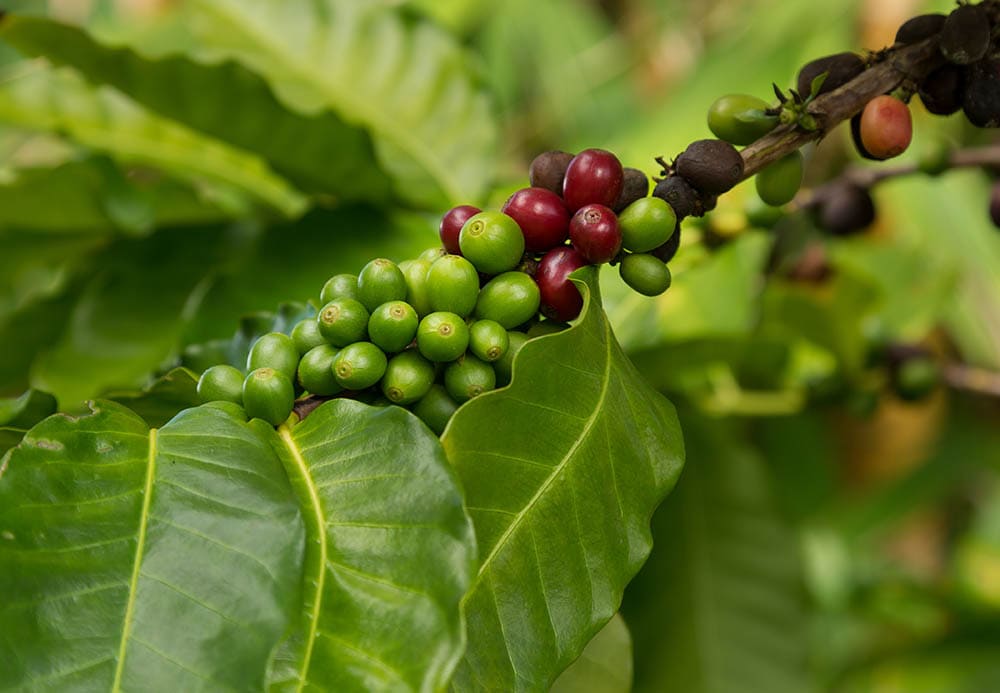
If you’re buying coffee from a mom-n-pop roastery, or even from a larger chain like Starbucks, chances are that they are roasting coffee mostly from places that are not in the United States. Coffee has a long history and has been consumed in many parts of the world for centuries.
Most people know the story that is said to have taken place in Ethiopia. Kaldi, a goatherd, discovered one of his goats “hyped-up” from eating the cherries of what we know today as the coffee shrub or tree (depending on the size). Whether this story is a myth or fact is beside the point. Coffee consumption most likely originated in Ethiopia. It spread east into the Arabian Peninsula and, with the advent of Islam, spread throughout the rest of the Middle East and into the Mediterranean region.

Where is Coffee Grown in the US? The 3 Places
So, here we are today on the other side of the globe. While Indonesia and Ethiopia remain in the top five coffee exporters worldwide, the front-runners are in the West, Brazil, and Colombia namely. But for those of us who live in the United States, maybe we want something local. Where is coffee grown in the United States, if at all? Coffee thrives south of the Equator- can it grow even in the southern regions of the US?
1. Hawaiian Kona Coffee
Coffee has a long history, too long to share the entirety of it here. Coffee was first introduced to Hawaii in 1823 when Chief Boki, who served as a royal governor of Oahu, was returning from completing a diplomatic mission to England on behalf of the lately deceased King Kamehameha II. Chief Boki stopped in Brazil on his return and discovered the coffee plant. He took a clipping of the Brazilian coffee plant and brought it to Oahu where he began to propagate it. Just five years later in 1828, the Rev. Samuel Ruggles, a missionary, brought the coffee plant from Chief Boki’s farm to the district of Kona on the same island to beautify the district with the red cherries of the plant.
Kona turned out to be the ideal area on the Big Island to grow coffee. Kona has young volcanic soil which is rich in minerals. Afternoon showers and breezes contribute to the moisture being pulled up onto the island, creating the perfect climate in the middle of the Pacific to grow coffee year-round.
Hawaiian Kona coffee is very popular due to its relatively medium body with floral and fruity notes. It is a crowd-pleaser. It’s lucky for those of us in the states that what is one of the only qualifying climates for growing coffee (20 degrees north of the equator), turned out to be an ideal climate to grow beans that yield one of the most delicious cups you can find.
You can save 15% on any of Volcanica’s gourmet single-origin coffee beans — including Extra Fancy Kona Coffee — using code CA22!
2. California
https://www.instagram.com/p/CRMPBLYMY3M/
In the hills of southern Santa Barbara County is pretty much the only place coffee is grown in the continental United States.
In 2002, Jay Ruskey, who would later establish what is now known as Frinj Coffee, Inc., began to experiment with growing non-native crops to California. So, he experimented with coffee in Goleta, California, the birthplace of the continental American coffee industry.
Jay found that his already existing avocado trees had something to gain from the coffee plants being grown in their midst, and vice versa. This was the sweet beginning of what became a mutually beneficial relationship for both of these crops. The avocado trees provided the shade necessary for the coffee plants and the coffee trees absorb the water intended for the avocado trees that would otherwise be wasted. They also require the same types of soil in terms of pH levels, minerals, etc.
Coffee plants arrived in California from Ethiopia by way of Panama. This means that there is quite a history in terms of breeding coffee plants. Growing coffee in California is still something of an experiment, so there is no single, clearly defined flavor profile.
3. Puerto Rico
While not numbered among the 50 States of the United States, Puerto Rico has been growing coffee since 1736. In 1890, Puerto Rico was the world’s sixth highest exporter of the magic bean. Unfortunately, throughout the late 19th and 20th centuries, many of the crops were devastated by hurricanes and other tropical storms.
Since coffee is such a staple in Puerto Rican culture, the supply has been unable to keep up with local demand. Puerto Ricans have opted to import coffee from South America in order to keep up with consumption. But more people than ever are demanding coffee specifically from Puerto Rico, so some entrepreneurs are coming up with solutions to increase the amount of coffee grown there.
Unfortunately, Hurricane Maria in 2017 was not an isolated incident. This storm represents what is always a possibility for the region. So, the industry seems to grow two steps forward and one backward. Nevertheless, progress is being made.

In Conclusion
Perhaps unsurprisingly, most of the US is not suitable for growing coffee. Others have tried and failed to produce coffee across the country, but for now, Hawaii, California, and Puerto Rico are the only places producing coffee on a sustainable scale.
See Also: Can You Grow Coffee in Florida? What to Know!
Featured Image Credit: Steve Heap, Shutterstock















